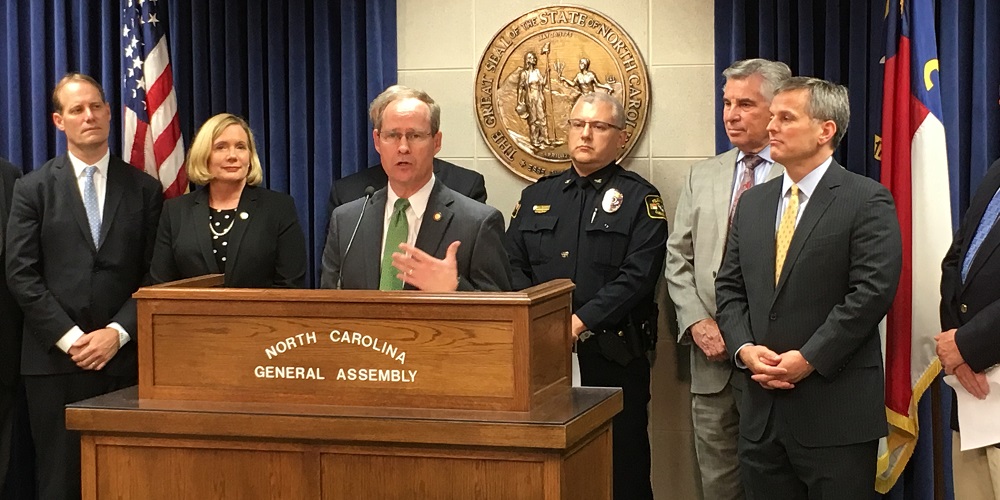How is North Carolina
Addressing the Epidemic?
North Carolina has responded to the opioid epidemic with three recent laws drafted by Attorney General Josh Stein’s office and sponsored by Representatives Greg Murphy and Craig Horn, Senators Jim Davis and Tom McInnis, and other members of the North Carolina General Assembly.

The Strengthen Opioid Misuse Prevention (STOP) Act
The STOP Act (2017) aims to reduce the number of people who become addicted to prescription opioids. The Act:
- Sets a 5-day limit for an initial prescription for acute pain (7 days for pain following surgery) to reduce the number of people who become addicted to pain medications and reduce the number of unused pills sitting in medicine cabinets
- Requires prescribers to check the Controlled Substances Reporting System database before prescribing opioids to reduce adverse drug interactions, duplicative prescriptions and doctor-shopping
- Requires electronic prescribing of opioids to cut down on prescription fraud
The Synthetic Opioid Control Act
The Synthetic Opioid Control Act (2017) helps law enforcement authorities go after fentanyl traffickers by ensuring that all derivatives of this deadly drug are classified as controlled substances under state law.
The Heroin and Opioid Prevention and Enforcement (HOPE) Act
The HOPE Act (2018) gives law enforcement authorities tools for addressing the opioid epidemic. The Act:
- Ensures that our drug trafficking laws cover trafficking in the deadly drug fentanyl
- Gives law enforcement quicker access to the information they need to investigate diversion of prescription drugs from legal to illegal uses
- Protects patient safety by strengthening laws against theft of drugs by healthcare workers and first responders
- Expresses the General Assembly’s intent to provide greater funding for drug treatment and recovery services
In North Carolina, our counties, cities and towns have been actively addressing the opioid epidemic through a wide range of creative initiatives and strategies.
Does North Carolina
Have an Opioid Action Plan?
North Carolina’s Opioid Action Plan was developed with community partners to combat the opioid crisis. Strategies in the plan include:
- Reducing the oversupply of prescription opioids
- Reducing the diversion of prescription drugs and the flow of illicit drugs
- Increasing community awareness and prevention
- Making naloxone widely available
- Expanding treatment and recovery systems of care
- Measuring the effectiveness of these strategies based on results
- Coordinating the state’s infrastructure to better tackle the opioid crisis
Learn more about the Opioid Action Plan here.
The Opioid and Prescription Drug Abuse Advisory Committee (OPDAAC) works to implement the Opioid Action Plan.
How is the Federal Government
Addressing the Epidemic?
Strategies developed by the federal government to address the opioid epidemic fall into five areas:
- Prevention strategies aim to stop substance misuse before it starts.
- Intervention strategies seek to identify and assist specific individuals who are at risk or need help.
- Through treatment and recovery, people with substance use disorders work to stop using harmful substances and to heal themselves, their relationships and their lives.
- Harm reduction strategies save lives and reduce the spread of disease by distributing naloxone, operating syringe exchanges and connecting people with substance use disorders to treatment and other services.
- Law enforcement authorities work to stop diversion of prescription drugs and trafficking in illicit drugs. Many in law enforcement now carry naloxone to reverse overdoses and support efforts to deflect individuals with substance use disorders into treatment.
U.S. Department of Health and Human Services
Additionally, the U.S. Department of Health and Human Services is responding to the crisis by focusing its efforts on five major priorities:
- Improving access to treatment and recovery services
- Promoting use of overdose-reversing drugs
- Strengthening our understanding of the epidemic through better public health surveillance
- Providing support for cutting-edge research on pain and addiction
- Advancing better practices for pain management
Learn more about the federal response here.
The National Institutes of Health
The National Institutes of Health—the nation’s leading medical research agency—is helping address the opioid crisis by seeking new and better ways to prevent opioid misuse, treat opioid use disorders and manage pain.
Learn More about their efforts here.
The Centers for Disease Control
The Centers for Disease Control is also working to protect public health and prevent opioid overdose deaths.

